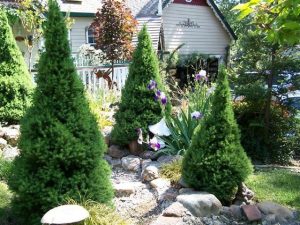The best time to plant a tree was 20 years ago. The second-best time is now. This attributed old Chinese proverb holds true even today. Fall is a great time to get your planting done, both for your plants and for you.
A plant’s life is controlled by weather and light. Our inland foothill summers with their long, hot days are tough on newly planted shrubs or trees. Autumn’s cooler air temperatures, warm soil temperatures and shorter day light will help plants acclimate with less stress. Cooler temperatures provide higher soil moisture due to less evaporation. New plantings in the fall have enough root development initially to handle the plants’ water volume needs while the roots continue to develop prior to the first freeze. Cooler weather will require some but far less watering than in the summer. With the potential for California’s late fall rains and some required watering by humans, the root system will not dry out in the fall.
Plants, like all living beings, respond to different seasons with different physical reactions. During the fall, above-ground plant growth slows down. Transpiration, the loss of water from plant tissues in the form of vapor through the stomata, is low. (Stomata are the cells or pores that move gases and water vapor out of the plant.) While the top slows, the bottom begins to grow to deal with upcoming weather conditions. Root growth occurs when soil temperatures are warm, soil moisture levels are higher, and air temperatures are stable. The bottom line? Fall planting benefits from favorable soil temperatures and moisture conditions that create root growth that is needed to keep your new plants alive that first critical year.
Fall planting is better for you too. The temperatures are cooler and it is easier to dig. If you have particular fall colors in mind you may be able to see what the plant will produce in the future. The competition with weeds is gone since they are grouping their forces for a big push in spring.
Just as a sudden hot spell will damage new planting, so will frozen ground. The optimal planting time is up to six weeks before the ground freezes. Once the ground freezes, root growth will stop until spring. The six week time element gives the plant time to become established enough to deal with any upcoming wind and snow.
A plant’s best friend is mulch, that insulating blanket in winter. It stimulates root growth (by keeping soil temperatures and moisture levels higher), thus preparing the plant for the spring time growth up-tick. Mulch is a lifesaver for plants year round.
However, do have realistic expectations for your fall planting. Some plants will just not do well if the weather turns. Varieties that typically suffer winter damage should be avoided. Evergreens that do not have a full root system established due to late planting should be avoided.
Plants that retain foliage all winter will be more likely to dry out with heavy winds. Some plants are known to be less hardy; they should be planted in spring when weather variables are more consistent. Some plants that are slower to establish need earlier or spring-only planting. These include conifers like pine and spruce, fir, birch, ginkgo, sweet gum, oaks, and willows.
So the best time to plant a tree was twenty years ago. But, in most cases, fall planting is the perfect, second best time for you and your plants.
Julie Silva is a University of California Cooperative Extension Master Gardener of Tuolumne County.
UCCE Master Gardeners of Tuolumne and Calaveras Counties can answer home gardening questions. Call 209-533-5912 or to fill out our easy-to-use problem questionnaire here. Check out our website here, You can also find us on Facebook.

